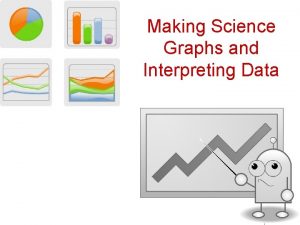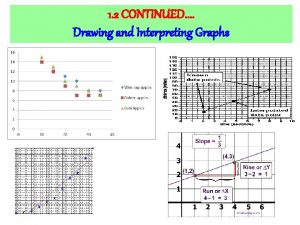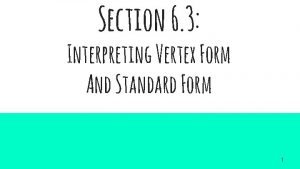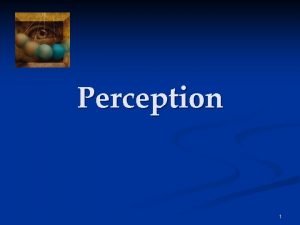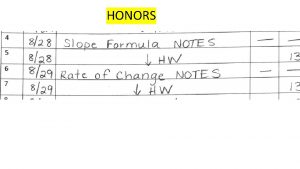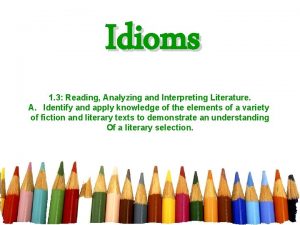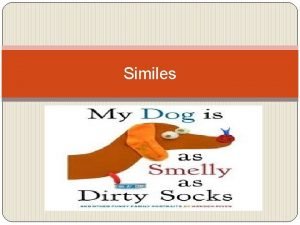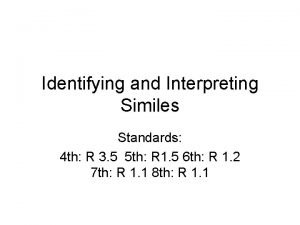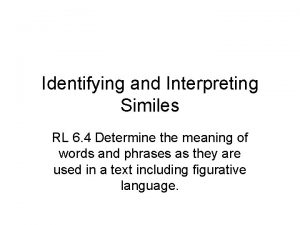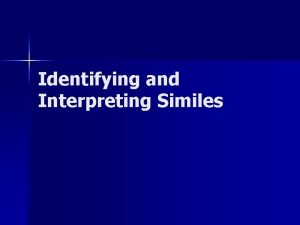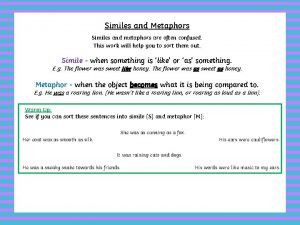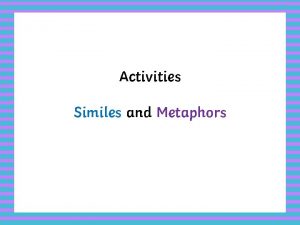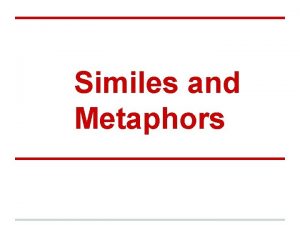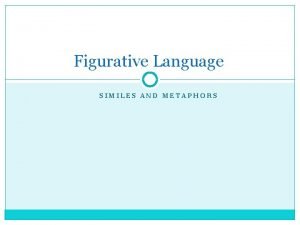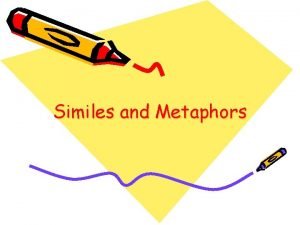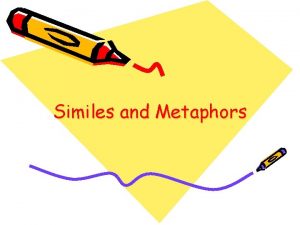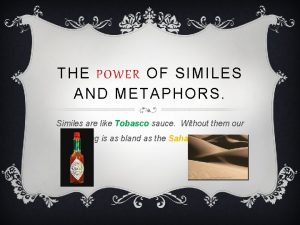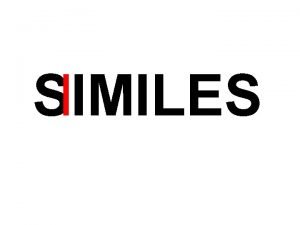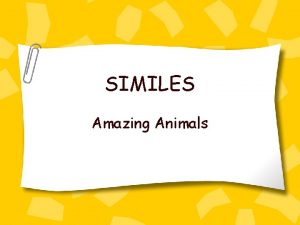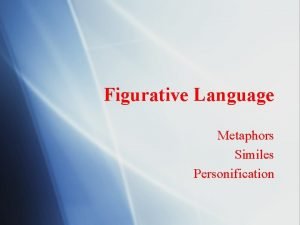Identifying and Interpreting Similes Standards RL 7 4

















- Slides: 17

Identifying and Interpreting Similes Standards: RL 7. 4

Learning Objective • Today we will identify 1 and interpret 2 similes. • 1 find • 2 make meaning from

Compare these two pictures. Think about how they are alike. Pair -share with your partner. Write one (adjective) descriptive word in your journal that describes both pictures. chili sun The chili and the sun are both______. Today we will be using a specific kind of figurative language called similes. APK

• A simile is a figure of speech that compares two unlike things using “like” or “as. ” Example(s): Cold lemonade is as refreshing as a dip in the pool. Playing chess with Ashley is like trying to outsmart a computer. His temper was as explosive as a volcano. – Non-example: I like pizza. concept

• What is a simile? • Which is an example of a simile? –A. She’s as fast as lightning. –B. We like to play games. How did you know that?

It’s important to identify and interpret similes because… • they make language more dramatic in fewer words. • they help you understand appreciate literature. • they help us to better understand or “see” what the author is saying. • they are tested on PARCC English test

Steps to identify and interpret similes: • 1. Read the sentence(s) • 2. Identify and underline what is being compared. • 3. Identify the type of figurative language: – If “like” or “as” is used = simile • 4. Interpret using textual clues.

She listens to the teacher and always seems to have the answers. Karen has a mind trap. _____ like a steel ______ • 1. Read the sentence(s) • 2. Identify and underline what is being compared. • 3. Identify the type of figurative language: – If “like” or “as” is used = simile • 4. Interpret using textual clues. Interpretation: She remembers everything. Skill/guided practice “I do” CFU: How did I identify the simile? P/S How did I interpret the simile? P/S

The President and his wife arrived at the formal celebration. Her evening ______ gown ______ sparkled like a diamond. • 1. Read the sentence(s) • 2. Identify and underline what is being compared. • 3. Identify the type of figurative language: – If “like” or “as” is used = simile • 4. Interpret the simile using textual clues. Interpretation: Her gown was beautiful. CFU: How did we identify the simile? P/S How did we interpret the simile? P/S Skill/Guided Practice “We do”

The baby was like an octopus, ___________ grabbing at all the cans on the grocery store shelves. • 1. Read the sentence(s) • 2. Identify and underline what is being compared. • 3. Identify the type of figurative language: – If “like” or “as” is used = simile • 4. Interpret using textual clues. Interpretation: The baby was misbehaving. Skill/Guided “You do” CFU: How did you identify the simile? P/S How did you interpret the simile? P/S

Extra Guided Practice… Paul Bunyan was huge. His feet were as big as boats. It is said that when Paul walked, his footprints formed the Great Lakes. Those girls are like two peas in a pod. They play together at every recess, and often dress the same at school.

Applying this to Red Kayak • Today you will create a T-chart that lists examples of simile in the novel we are reading. • You will write the sentence with the simile on the left side and your interpretation of its meaning on the right side.

Simile and Pg. # Interpretation Write the page number first. Then, Explain in your own words. what the copy the sentence from the text and author meant or what they wanted us underline what is being compared. to understand by using this simile. 1) Pg. 5 - I still marvel at how all those tiny ripples in the water can catch the sunlight and make the river shimmer like a million jewels were strewn on the surface. 2) Pg. 5 - 1)Shows how beautiful and valuable the river is to Brady.

Simile and Pg. # Interpretation Write the page number first. Then, Explain in your own words. what the copy the sentence from the text and author meant or what they wanted us underline what is being compared. to understand by using this simile. 3)Pg. 11 4)Pg. 13 5)Pg. 17 6)Pg. 22 7)Pg. 23 8)Pg. 30

Closure • What is a figure of speech that compares two unlike things using like or as? • Why is it important to identify and interpret similes?

I walked along the beach and listened to the ocean. My ______ sadness ____ was as unending as the waves. • 1. Read the sentence(s) • 2. Identify and underline what is being compared. • 3. Identify the type of figurative language: – If “like” or “as” is used = simile • 4. Interpret using textual clues. My interpretation is___________. Closure: Skill check

Independent practice • Directions: Read the sentences. Identify the simile and underline what is being compared. Interpret using textual clues.
 Identifying and non identifying adjective clauses
Identifying and non identifying adjective clauses Non identifying adjective clauses examples
Non identifying adjective clauses examples Information essential
Information essential Identifying similes
Identifying similes Customer defined service standards
Customer defined service standards Creating and interpreting graphs and tables
Creating and interpreting graphs and tables Interpreting graphs science
Interpreting graphs science Drawing and interpreting graphs
Drawing and interpreting graphs Vertex form
Vertex form Selecting organizing and interpreting information
Selecting organizing and interpreting information Analyzing and interpreting quantitative data
Analyzing and interpreting quantitative data 5-1 rate of change and slope
5-1 rate of change and slope Planning recording analyzing and interpreting
Planning recording analyzing and interpreting What is research design
What is research design Analyzing and interpreting data in research
Analyzing and interpreting data in research Analyzing and interpreting data in research
Analyzing and interpreting data in research Barking up the wrong tree sentence
Barking up the wrong tree sentence Analyzing and interpreting data in research
Analyzing and interpreting data in research






